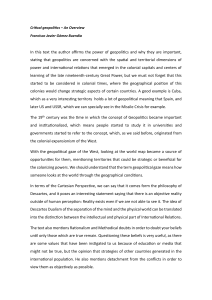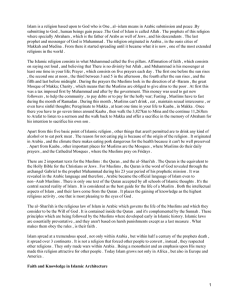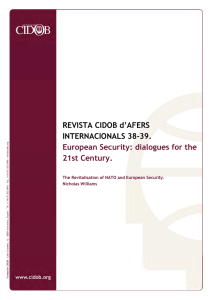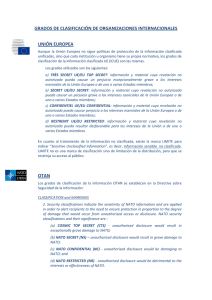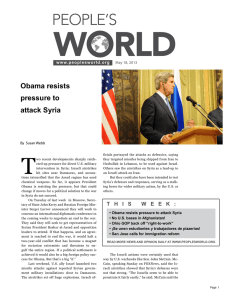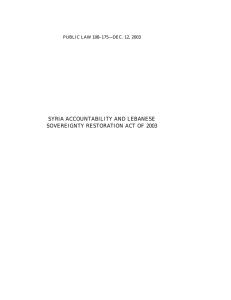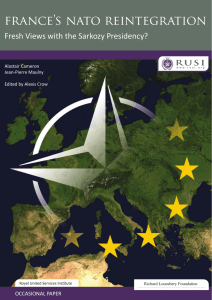An End-of-Time Utopia: Understanding the Narrative of the Islamic
Anuncio
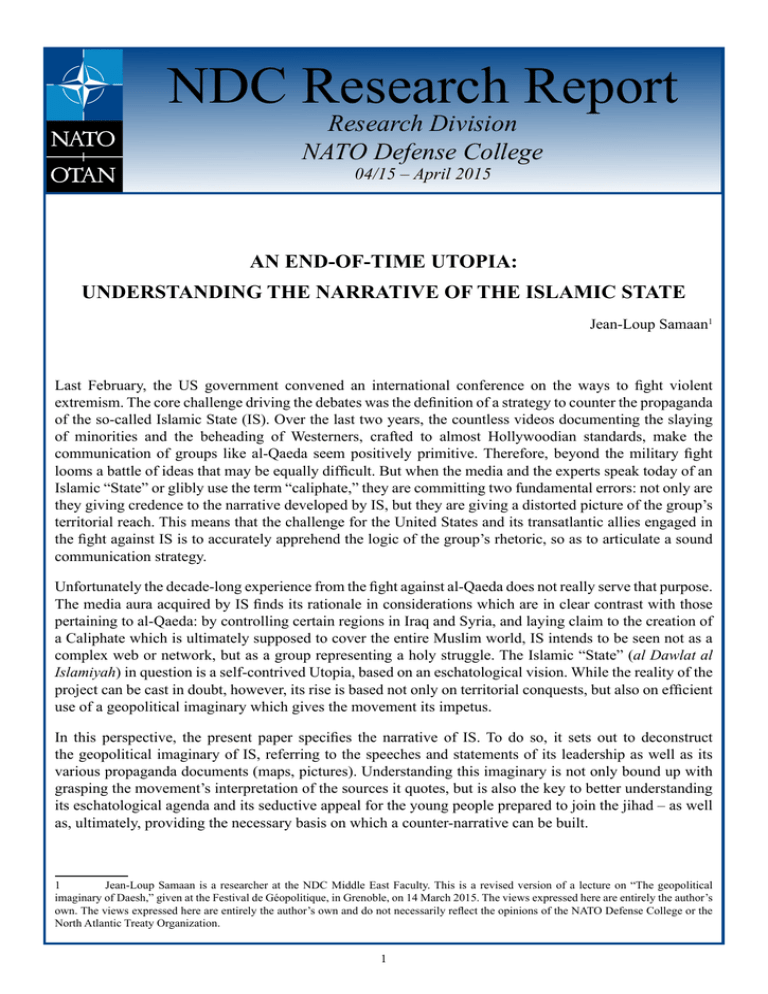
NDC Research Report Research Division NATO Defense College 04/15 – April 2015 An End-of-Time Utopia: Understanding the Narrative of the Islamic State Jean-Loup Samaan1 Last February, the US government convened an international conference on the ways to fight violent extremism. The core challenge driving the debates was the definition of a strategy to counter the propaganda of the so-called Islamic State (IS). Over the last two years, the countless videos documenting the slaying of minorities and the beheading of Westerners, crafted to almost Hollywoodian standards, make the communication of groups like al-Qaeda seem positively primitive. Therefore, beyond the military fight looms a battle of ideas that may be equally difficult. But when the media and the experts speak today of an Islamic “State” or glibly use the term “caliphate,” they are committing two fundamental errors: not only are they giving credence to the narrative developed by IS, but they are giving a distorted picture of the group’s territorial reach. This means that the challenge for the United States and its transatlantic allies engaged in the fight against IS is to accurately apprehend the logic of the group’s rhetoric, so as to articulate a sound communication strategy. Unfortunately the decade-long experience from the fight against al-Qaeda does not really serve that purpose. The media aura acquired by IS finds its rationale in considerations which are in clear contrast with those pertaining to al-Qaeda: by controlling certain regions in Iraq and Syria, and laying claim to the creation of a Caliphate which is ultimately supposed to cover the entire Muslim world, IS intends to be seen not as a complex web or network, but as a group representing a holy struggle. The Islamic “State” (al Dawlat al Islamiyah) in question is a self-contrived Utopia, based on an eschatological vision. While the reality of the project can be cast in doubt, however, its rise is based not only on territorial conquests, but also on efficient use of a geopolitical imaginary which gives the movement its impetus. In this perspective, the present paper specifies the narrative of IS. To do so, it sets out to deconstruct the geopolitical imaginary of IS, referring to the speeches and statements of its leadership as well as its various propaganda documents (maps, pictures). Understanding this imaginary is not only bound up with grasping the movement’s interpretation of the sources it quotes, but is also the key to better understanding its eschatological agenda and its seductive appeal for the young people prepared to join the jihad ‒ as well as, ultimately, providing the necessary basis on which a counter-narrative can be built. 1 Jean-Loup Samaan is a researcher at the NDC Middle East Faculty. This is a revised version of a lecture on “The geopolitical imaginary of Daesh,” given at the Festival de Géopolitique, in Grenoble, on 14 March 2015. The views expressed here are entirely the author’s own. The views expressed here are entirely the author’s own and do not necessarily reflect the opinions of the NATO Defense College or the North Atlantic Treaty Organization. 1 Imaginary view of the final battle, according to Islamic State. Source: Twitter. From Iraqi Beginnings to Propagation in Syria While al-Qaeda in the 1990s spread through the Arab world before establishing its presence elsewhere, this was not the case with IS. Its roots can be traced back to Iraq in the 2000s, with the emergence of jihadist movements such as Ansar al Islam and Abu Mussab al-Zarqawi’s Jamaat Al Tawhid wa al Jihad. Al-Zarqawi officially swore allegiance (bay’a) to al-Qaeda in September 2004, and the group was renamed Tanzim Qaidat al-Jihad fi Bilad al-Rafidayn (literally “Organization base of jihad/Mesopotamia”). Yet the organization was no mere appendage of al-Qaeda, having its own agenda and strategy. In particular, alZarqawi made the religious war between Sunni and Shia the cornerstone of his terrorist strategy, leading to gradual divergences of opinion with Ayman Zawahiri and Osama Bin Laden2. After al-Zarqawi’s death in the summer of 2006, al-Qaeda in Mesopotamia became closely involved with the Mujahideen Shura Council of Iraq, an alliance of six relatively unimportant movements. Together, they decided in the autumn of that year to found Dawlat al Iraq al Islamiyah, the Islamic State of Iraq (ISI). This new organization can probably be seen as the first embryo of IS as we know it today. With the US Military’s “surge” in 2007 and the Sahwa movement receiving the support of Sunni tribal leaders, ISI’s influence decreased considerably but did not disappear. In 2010, Abou Bakr al-Baghdadi became the leader of ISI; a year later, as US forces started to wind down their presence in Iraq, the movement unleashed repeated attacks on the major cities, particularly Baghdad. The next few months saw Syria sink into a bloody civil war. ISI leadership quickly seized the opportunity created by the rise of groups declaring allegiance to the same Islamist agenda. In June 2013, al-Baghdadi announced a merger between ISI and Jabhat al Nusra, a group formed in early 2012 by Abou Mohammad al Julani. This resulted in the creation of Al Dawlat Al Islamiyat fil Iraq wa ash Sham (giving the Arabic acronym Daesh), loosely translated as Islamic State in Iraq and the Levant (ISIL). There was, however, a degree of confusion regarding al-Baghdadi’s announcement: Al Julani, the Jabhat al Nusra leader, denied the merger the very next day, and stated that his movement continued to have a separate existence. Nevertheless, ISIL was now a fact of life. 2 See the analysis of al-Zarqawi’s texts: Jean-Pierre Milelli, “Abou Moussab al-Zarqawi, le jihad en ‘Mésopotamie’” in: Gilles Kepel (Ed.), Al-Qaida dans le texte, Paris, PUF, 2005. 2 English or French translations of the name are misleading, since they omit the Arabic word “Sham.” This introduces a distortion which fails to convey the geopolitical imaginary of Daesh. The term “Levant” comes from medieval French and, in the Western tradition, was essentially associated with the nineteenth century Orientalism popularized by poets and writers setting out to explore the Middle Eastern regions of the Ottoman Empire. In the 20th century, the term came to be used more restrictively, in reference to the French Mandate for Syria and the Lebanon. The Arab word “Sham” refers to a totally different story ‒ that of the Caliphate (“bilad ash Sham”), meaning Syria in the Umayyad and Abbasid periods. The term is so deeply rooted in Arab and Muslim culture that people in the Middle East refer to Damascus not as “Dimashq” (its literal translation), but simply as “Sham.” This linguistic nuance allows us to better understand the symbolic meaning of the video widely circulated by ISIL in June 2014, entitled “The end of Sykes-Picot.” The mistranslation “Levant” fails to convey how, from the moment of its inception, ISIL has been creating an alternative narrative which rejects modern historiography and reinstates the historical tradition of the Muslim Caliphate. The video thus enables us to walk, side by side with a jihadist, along the Syrian-Iraqi border. In front of the camera, the jihadist constantly declares that the abolition of this border marks the death of the Anglo-French Sykes-Picot Agreement, drawn up in 1916 to divide the Ottoman Middle East into French and British spheres of influence and control. The symbolic value of “Sykes-Picot” extends beyond the jihadist narrative and draws in the whole of the Arab world. Sykes-Picot has entered into the collective imaginary in the Middle East, as a byword for the imperialist agendas of the European powers. The fact that the agreement was quickly challenged by international events at that time3 is less relevant here than its presence in the school textbooks assimilated by generations of young Syrians, Lebanese and Iraqis, so that leveraging this reference is a strategic choice to give ISIL’s message a seductive appeal for the Arab populations it targets. The Caliphate, or the Staging of a Geopolitical Fiction After extending its battle to Syria, ISIL became far more ambitious and, on 29 June 2014, announced the creation of the Caliphate. This was no longer to be called Al Dawlat Al Islamiyat fil Iraq wa ash Sham, but simply Al Dawlat Al Islamiyah, or Islamic State. It was an unprecedented move for a terrorist group. Abu Bakr al-Baghdadi, who had until then been the Emir, thus attained the status of Caliph. There is also a biography, said to be official, which circulates among Islamist groups and presents him as a knowledgeable theologian. He allegedly holds a PhD from the Islamic University of Baghdad and is a member of the Qureshi tribe (the tribe of the prophet).4 Not only has al-Qaeda never claimed to control a territory, but Bin Laden never set out to recreate the Caliphate. By and large, the declared aspirations of extremist Islamic groups until last year had been limited to creating an Emirate (the Taliban in Afghanistan), or an Islamic State ‒ or, more precisely, Republic (Iran, Pakistan, Mauritania). In Daesh’s message of June 2014, spokesperson Abu Muhammad Al Adnani declared that “it is incumbent upon all Muslims to pledge allegiance to the khalifah Ibrahim [al-Baghdadi] and support him (may Allah preserve him). The legality of all emirates, groups, states, and organizations, becomes null by the expansion of the khilafah’s authority and arrival of its troops to their areas.”5 The 3 James Barr, A Line in the Sand: Britain, France and the Struggle that Shaped the Middle East, London, Simon & Schuster, 2012. 4 “A Biography of Abu Bakr al-Baghdadi,” SITE, 12 August 2014. Downladable at: http://news.siteintelgroup.com/blog/index.php/entry/226-thestory-behind-abu-bakr-al-baghdadi (accessed 17/03/2015). 5 Translation of the speech available at: https://news.siteintelgroup.com/Jihadist-News/isis-spokesman-declares-caliphate-rebrands-group-as-islamicstate.html (accessed 17/03/2015). 3 announcement might meet with the approval of illiterate masses, but is obviously rejected by most Muslim clerics. When asked for his opinion on the subject, the influential Egyptian preacher Yusuf Al Qaradawi publicly stated that this declaration was a violation of the Sharia.6 The term “caliphate” presupposes the unity of the Muslim world, and its undivided allegiance to the authority of a single figure. In other words, IS, which controls a strip of land between Syria and Iraq (with a population which runs at most into tens of millions), is now claiming to have authority over 1.5 billion Muslims worldwide. In recent months, this spectacular use of propaganda has nevertheless brought a number of organizations, based much further afield than Syria and Iraq, to identify themselves with IS. Conquests Far from the “Caliphate” In the summer of 2014, the seizure of a number of regions in Syria and Iraq by IS rapidly elevated it to the leading ranks of Islamic terrorist groups. From September 2014, “franchises” sprang up among organizations often far removed from the Syrian and Iraqi theatre. In Algeria, a faction led by Abdelmalek Gouri broke away from al-Qaeda in the Islamic Maghreb, announcing its allegiance to IS on 14 September. The breakaway group styled itself Jund al Khilafah, the soldiers of the Caliphate. A week later, they kidnapped and murdered the French tourist Hervé Gourdel. Jund al Khilafah became IS’s first offshoot in Africa. Its leader Abdelmalek was killed in late December, in an operation by the Algerian army. His successor is said to be Abu Abdallah al Asimi. A month after the appearance of the Algerian “branch,” another franchise was created in Libya: this time, the Council of Islamic Youth in Derna (the hometown of the Battar Brigade, created in 2012 by Libyan fighters in Syria) declared allegiance to IS. This group was subsequently responsible for the attack on the Hotel Corinthia, on 27 January 2015. On 15 February, a video posted on Internet showed its members beheading 21 Egyptian Copts. Just a week later, they staged an unsuccessful attack on the Iranian Embassy in Tripoli. Finally, on 9 March, they kidnapped nine foreign workers (five Filipinos, an Austrian, a Bangladeshi, a Czech and a Ghanaian) during a raid on an oilfield south east of Tripoli. IS has also attracted support in the Sinai region of Egypt, where the Ansar Beit al Maqdis group (“Supporters of the Holy House”) has pledged its allegiance. This group had already been involved in attacks on the Egyptian army. Finally, in Nigeria, Boko Haram joined the Caliphate in early March. Its leader, Abu Bakar Shekau, had acclaimed the proclamation of the Caliphate as early as 13 July 2014. 6 Al Arabiya News, “Qaradawi says ‘jihadist caliphate’ violates sharia,” 5 July 2014. 4 Map of the Caliphate according to Islamic State militants In the case of these franchises, too, IS differs from al-Qaeda in its choice of terminology. While regional offshoots of al-Qaeda were called “organizations” (tanzimaat), branches of Daesh are referred to as “wilayaat” (the historic name for the provinces of the original Caliphate). Thus, Cyrenaica becomes “wilayat Barqa.” In Egypt, Ansar Beit al Maqdis has the franchise for “wilayat Sinai.” Algeria becomes “wilayat al Jazair.” Sometimes, a few public declarations by local jihadists are enough for a group to annex other territories: in Saudi Arabia, “wilayat al Haramayn” (literally, “province of the two holy places”) was created in this way, while Yemen has the area referred to as “wilayat al Yemen.” Finally, the movement was joined by Pakistani Taliban, with the creation of “wilayat Khorasan.” While al-Qaeda saw its franchises as local footholds for operations against the Western presence in Muslim lands, the “wilayaat” are part of IS’s geopolitical aim of re-establishing the full geographical extension of the Caliphate. In most cases, however, the fighters concerned have little if any effective control over the regions to which they lay claim. In this respect, IS is a project which could be defined as a Utopia. Rome and the Battle of Dabiq Finally, the geopolitical agenda of IS gives great importance to “Rome,” with many references to it in the group’s propaganda and in the speeches of its leaders. Al-Baghdadi has, on several occasions, mentioned the conquest of “Rome” as one of the group’s objectives. His spokesperson Abu Mohammad al Adnani proclaims, “We will conquer your Rome, break your crosses, and enslave your women.”7 7 http://www.theatlantic.com/features/archive/2015/02/what-isis-really-wants/384980/ 5 Cover of the Islamic State propaganda magazine, Dabiq “Rome,” in this context, is not literally a reference to the Italian capital, but a synecdoche for the Christian West as a whole. In this respect, naming the magazine after the Syrian town of Dabiq is not a chance, trivial reference. At first sight, it might seem strange that a small town of 3,000 inhabitants, situated close to the Syrian-Turkish border, should be so much in the limelight. However, Dabiq has a special place in Islamic symbolism. The town is mentioned, in a hadith of the Koran, as the site of one of the battles which would mark the end of time (malahim, in Koranic terminology). The original text states the prophet’s words as follows: “The Last Hour would not come until the Romans would land atal-A’maq or in Dabiq. An army consisting of the best (soldiers) of the people of the earth at that time will come from Medina (to counteract them). When they will arrange themselves in ranks, the Romans would say: ‘Do not stand between us and those (Muslims) who took prisoners from amongst us. Let us fight with them;’ and the Muslims would say: ‘Nay, by Allah, we would never get aside from you and from our brethren that you may fight them.’ They will then fight.”8 This is a fundamental aspect of IS ideology: its eschatology. Al-Qaeda’s agenda, from the outset, was clearly political: to target Western enemies and their allies in the Arab world. To do so, al-Qaeda carried out spectacular terrorist attacks which were intended to trigger regional revolutions. However, Bin Laden’s vision was never messianic in scale and involved no apocalyptic battles. This is the register in which IS wishes to express itself. Its messianism is not to be underestimated: it explains much of the movement’s attraction for young Arabs or Europeans, in search of adventure and imbued with little if any religiosity. For these budding fighters, the violent battles between IS and the US-led coalition in northern Syria are no chance occurrence: they mark the start of the final struggle between Muslims and their enemies, the armies of “Rome.” This is one of the reasons why the Western debate on the “statehood” of IS misses the point. The concept of the state (dawla), in the usage of Islamic State, has very little to do with the concept we refer to within the modern Westphalian system. IS leaders do not aim to create a state which would become part of the international community, but one which would mark the end of history. 8 http://www.theonlyquran.com/hadith/Sahih-Muslim/?volume=41&chapter=9 6 *** Far from being a simply irrational and delirious transcription, the geopolitical discourse of IS has its own inner coherence. From a literal reading of the Koran and Muslim historiography, the group adopts carefully chosen rhetoric and terminology. We could simply retort that this is an archaic and aberrant reading of Islam, but that would not really concern the target addresses of IS’s propaganda ‒ its potential recruits. IS’s claims and prophecies are, certainly, in no way consistent with its actual territorial extension, but this geopolitical imaginary and messianism must nevertheless be taken seriously. In other words, the real power of IS derives from the geopolitical narrative of the struggle for the Caliphate it crafted, rather than the reality of its territorial claims. Beyond the conflict in the air and on the ground, the decisive battle may well be over this narrative. For NATO countries engaged in the ongoing fight, monitoring the means by which IS conveys its propaganda (Twitter and other social networks) will not be enough. They will eventually need to elaborate a counter-narrative that addresses IS’s core message, so as to show it in a less attractive light and stop the increasing flow of foreign fighters joining the movement. The Research Division (RD) of the NATO Defense College provides NATO’s senior leaders with sound and timely analyses and recommendations on current issues of particular concern for the Alliance. Papers produced by the Research Division convey NATO’s positions to the wider audience of the international strategic community and contribute to strengthening the Transatlantic Link. The RD’s civil and military researchers come from a variety of disciplines and interests covering a broad spectrum of security-related issues. They conduct research on topics which are of interest to the political and military decision-making bodies of the Alliance and its member states. The opinions expressed are those of the authors and do not necessarily reflect the opinions of the North Atlantic Treaty Organization or the NATO Defense College. Printed copies of this paper can be obtained by contacting Mary Di Martino at m.dimartino@ndc.nato.int Research Division NATO Defense College - Via Giorgio Pelosi, 1 - 00143 Rome – Italy Jeffrey A. Larsen, PhD, Division Head website: www.ndc.nato.int 7 Follow us on Twitter at https://twitter.com/NDC_Research Printed and bound by DEd’A srl V.le Scalo San Lorenzo 55, 00185 Rome, Italy www.dedaedizioni.it Portions of this work may be quoted or reprinted without permission, provided that a standard source credit line is included. The Research Division would appreciate a courtesy copy of reprints. Please direct all enquiries to: m.dimartino@ndc.nato.int 8
